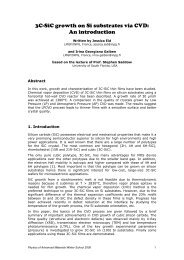Principles of Atomic rinciples Force Microscopy (AFM) - Mansic
Principles of Atomic rinciples Force Microscopy (AFM) - Mansic
Principles of Atomic rinciples Force Microscopy (AFM) - Mansic
Create successful ePaper yourself
Turn your PDF publications into a flip-book with our unique Google optimized e-Paper software.
Figure 1. Principle <strong>of</strong> STM (left) and <strong>AFM</strong> (right).<br />
2. Components <strong>of</strong> the microscope<br />
2.1. Piezocrystals<br />
Piezocrystals are ceramic materials that expand or contract in the presence <strong>of</strong><br />
voltage gradient and conversely, they develop an electrical potential in response<br />
to mechanical pressure. In this way, movements in x, y and z direction are<br />
possible.<br />
2.2. Probe<br />
The probe represents a micromachined cantilever with a sharp tip at one end,<br />
which is brought into interaction with the sample surface.<br />
Each probe has different specifications and shape. V-shaped cantilevers are the<br />
most popular (but also there are rectangular), providing low mechanical<br />
resistance to vertical deflection, and high resistance to lateral torsion. Cantilevers<br />
typically range from 100 to 200 µm in length (l), 10 to 40 µm in width (w), and<br />
0.3 to 2µm in thickness (t).<br />
Figure 2. Dimensions <strong>of</strong> the cantilever.<br />
Integrated cantilevers are usually made from silicon (Si) or silicon nitride (Si3N4).<br />
They are characterized by their force constant and resonant frequency, which<br />
have to be chosen according to the sample to be studied.<br />
Additionally an optical detection system and electronics for the management <strong>of</strong><br />
scanning procedures and data acquisition are necessary.<br />
Physics <strong>of</strong> Advanced Materials Winter School 2008 2




